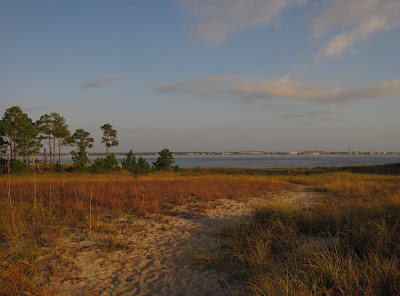The Gulf Islands National Seashore protects numerous barrier islands along the northern coast of the Gulf of Mexico in the Florida panhandle and the Mississippi coast. This national park unit protects some that are well out to sea and require a seasonal ferry to access, as well as, some sections right in the Pensacola urban sprawl.
The amazing white sand beaches are the result of almost pure quartz that has washed down over the eons from granite in the Appalachians to the north. Currents in the gulf sculpt these sands into long barrier islands, which not only provide important nesting and feeding grounds for sea turtles, marine birds, and a variety of endemic plants and animals, but also shield the mainland coast from the full brunt of hurricanes.
 |
| A heron with a fish a bit too large for its bill |
 |
| After struggling with it for about 5 minutes, somehow he got it into his throat |
We stayed at Fort Pickens Campground on Santa Rosa Island about 30 minutes from Pensacola. This is a wonderful campground, where you can walk from your campsite to the wild Gulf of Mexico side to the south and the tamer Pensacola Sound on the north. It is also very rare for an NPS campground in that it had electricity and hot showers. I suspect that is because in the summer, they realize people need air conditioners in their trailers and showers to wash off the sweat and salt after swimming all day to beat the heat.
 |
| The gulf-side beach just a short walk from the campground |
 |
| Looking into Pensacola Sound from the campground |
We also visited the Naval Live Oaks Area on the Gulf Breeze Peninsula. This area represents America's first attempt at managing timber. Virginia live oak was America's most important tree for building naval ships in the early 1800's due to its extraordinarily strong wood and straight grains. A 1 cubic foot chunk of this wood weighs 75 pounds! The USS Constitution in Boston was built from these oaks. But, extensive clearing of coastal live oak forests for both naval and merchant ships, often including illegal poaching on federal lands, caused President James Madison to sound the alarm to preserve an area for national emergencies.
 |
| Huge live oaks drapped in Spanish moss |
Naval Live Oaks Area was the first federal forest reserve and they used it to test various growing techniques and to try and develop a sustainable harvest. Today, the area contains some of the last old growth coastal live oak stands on the Gulf Coast and a beautiful subtropical environment that seemingly takes you to a land a 1000 miles south.
 |
| The almost tropical live oak area with magnola and palmettos in the understory |
The live oaks are also critical to helping coastal communities to survive the onslaught of hurricanes. When Hurricane Ivan rolled through the area in 2004, wind monitors discovered that these large oaks blocked the storms winds enough to reduce wind speeds by 15 mph! In addition, these barrier islands serve as a crucial wave break to absorb the energy of storm surges and to cut down on the energy supply entering the eye.
 |
| The pines were stripped bare and died. But, the palms and oaks have resprouted. |
Hurricane Ivan certainly wreaked havoc on Santa Rosa Island. The sand pines, long-leaf pines, palms, and oaks were stripped of their leaves and branches and many of them died. But, this is a landscape evolved to deal with disturbance. It did not take long for the oaks to resprout new leaves. While many of the pines are dead, their seedlings are popping up quickly to take advantage of the new light that is available. Soon, this forest will recover to absorb the brunt of the next hurricane that rolls through.
 |
| Sand pines who survived and those who didn't. |




















No comments:
Post a Comment